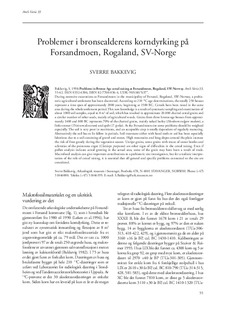| dc.contributor.author | Bakkevig, Sverre | |
| dc.date.accessioned | 2013-05-23T11:32:16Z | |
| dc.date.available | 2013-05-23T11:32:16Z | |
| dc.date.issued | 1998 | |
| dc.identifier.citation | Bakkevig, S. (1998) Problemer i bronsealderens korndyrking på Forsandmoen, Rogaland, SV-Norge. I Løken, T. Bronsealder i Norden - regioner og interaksjon : foredrag ved det 7. Nordiske bronsealdersymposium i Rogaland 31. august-3. september 1995 (55-62). Stavanger : Arkeologisk Museum i Stavanger | no_NO |
| dc.identifier.uri | http://hdl.handle.net/11250/181488 | |
| dc.description.abstract | During extensive excavations at Forsandmoen in the municipality of Forsand, Rogaland, SW-Norway, a prehistoric
agricultural settlement has been discovered. According to 210 14C age determinations, the totally 250 houses
represent a time span of approximately 2000 years, beginning at 1500 BC. Cereals have been raised in the same
area during the whole settlement period. This new knowledge is a result of systematic sampling and examination of
about 1000 soil samples, equal to 8 m3 of soil, which has resulted in approximate 20.000 charred cereal grains and
a similar number of other seeds, mainly of agricultural weeds. Grains from three bronze age houses from approximately
1400 and 800 BC represents 70% of the charred grains, mainly naked barley (Hordeum vulgare nudum), a
little emmer (Triticum dicoccum) and spelt (T. spelta). At the Forsandmoen site some problems should be weighted
especially. The soil is very poor in nutritients, and an acceptable crop is totally dependent of regularly manuring.
Alternatively the soil has to lie fallow in periods. Soil treatment either with hand tools or ard has been especially
laborious due to a soil consisting of gravel and stones. High mountains and long slopes around the plain increase
the risk of frost greatly during the vegetation season. Unripe grains, some grains with traces of snout beetles and
sclerotias of the poisonous ergot (Claviceps purpurea) are other signs of difficulties in the cereal raising. Even if
pollen analysis indicate cereal growing in the actual area, some of the grain may have been a result of trade.
Macrofossil analysis can give important contributions to a prehistoric site investigation, but for a realistic interpretation
of the role of cereal raising, it is essential that all general and specific problems connected to the site are
considered. | no_NO |
| dc.publisher | Arkeologisk Museum i Stavanger | no_NO |
| dc.relation.ispartofseries | AmS-Varia;33 | |
| dc.subject | arkeologi | no_NO |
| dc.subject | landbruk | no_NO |
| dc.subject | jordbruk | no_NO |
| dc.subject | bronsealder | no_NO |
| dc.subject | Forsandmoen | no_NO |
| dc.subject | Norge | no_NO |
| dc.title | Problemer i bronsealderens korndyrking på Forsandmoen, Rogaland, SV-Norge | no_NO |
| dc.type | Chapter | no_NO |
| dc.type | Peer reviewed | no_NO |
| dc.subject.nsi | VDP::Humanities: 000::Archeology: 090::Nordic archeology: 091 | no_NO |
